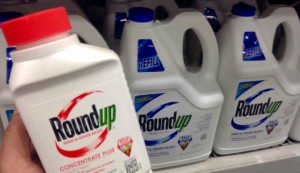13
May
Study Finds Low Levels of Roundup Cause Adverse Effects to Soil Health
(Beyond Pesticides, May 13, 2016) Raising questions about Roundup’s (glyphosate) effects on soil health, a study published last month shows that the chemical is toxic to soil fungus at doses well below levels which are recommended for agricultural use. The commercial formulation of Roundup is more toxic than technical active ingredient, glyphosate, highlighting the need to evaluate full formulation effects, including so-called inert ingredients.
 The study, published in Environmental Science and Pollution Research, looked at Roundup’s effects on a soil fungus, Aspergillus nidulans. Researchers found that a dilution of Roundup at a rate 100 times less than that allowed in agricultural production corresponded with 50% mortality of the fungus. A dose only 50 times lower than the recommended application rate for agricultural uses resulted in 100% mortality of the fungus. Even at the median lethal dose (LD50) and lower concentrations, researchers saw impaired growth, cellular polarity, endocytosis and mitochondria (impaired average number, volume and metabolism).
The study, published in Environmental Science and Pollution Research, looked at Roundup’s effects on a soil fungus, Aspergillus nidulans. Researchers found that a dilution of Roundup at a rate 100 times less than that allowed in agricultural production corresponded with 50% mortality of the fungus. A dose only 50 times lower than the recommended application rate for agricultural uses resulted in 100% mortality of the fungus. Even at the median lethal dose (LD50) and lower concentrations, researchers saw impaired growth, cellular polarity, endocytosis and mitochondria (impaired average number, volume and metabolism).
The study also found that Roundup has an effect on the soil fungus’ ability to break down nutrients for energy use. Rather than depleting mitochondrial activity, as found in animal cell studies, researchers found a stimulation of mitochondrial activity in the fungal cells, indicating a different mode of action. Researchers found that energy metabolism and respiratory disturbances were detected at the NOAEL (no-observed-adverse-effect-level) dose, showing that cellular level impacts could occur even with no outward impacts to growth or yield.
Glyphosate, the most widely used agricultural chemical in the world, has gained a nasty reputation for its effects on humans and wildlife, including soil biota. Beyond glyphosate’s recent classification as a carcinogen based on animal laboratory and epidemiologic studies by the International Agency for Research on Cancer of the World Health Organization, the chemical has been shown to harm earthworm populations, cause sub lethal damage to bees, drift and eliminate crucial habitat for monarch butterflies, and cause shape changes in amphibians.
Soil fungus, which is part of a wide range of soil biota, is essential to ecosystem functioning. Constant application of pesticides, such as glyphosate, in chemical-intensive agriculture can reduce soil diversity and therefore reduce soil functionality. Soil biota breaks down organic matter, enables chemical elements to be reused, and fixes nitrogen, which is necessary for nutrient in the ecosystem. A study published in February 2016 reveals that a decrease in soil biota impacts the services that healthy soil provides. The study finds that soil microbial diversity positively relates to multi-functionality in terrestrial ecosystems. Simply put, when soil diversity is high, the soil can function more efficiently and provide a multitude of ecosystem services. Any loss in microbial diversity will likely reduce multi-functionality, negatively affecting the services provided by soil, such as climate regulation through atmospheric carbon sequestration, fertility, and productivity. A further decline in soil biodiversity has adverse economic impacts as well. The European Academies’ Science Advisory Council (EASAC) estimates soil organisms and their role in agricultural productivity to be worth $25 billion a year, globally.
One way to protect soil biota, other wildlife, biodiversity, and the ecosystem as a whole from the harmful effects of pesticides is to support organic agriculture over conventional, chemical-intensive farming. Beyond Pesticides supports organic agriculture as effecting good land stewardship. The pesticide reform movement, citing pesticide problems associated with chemical agriculture, from groundwater contamination and runoff to drift, views organic as the solution to this serious environmental threat. It is impossible to discuss the ecological benefits of organic agriculture without discussing the devastating effects of conventional agriculture.
Conventional. or chemical-intensive, agriculture relies on toxic pesticides that contaminate air, water, soil, and living things, such as the soil fungus and other wildlife mentioned in the studies cited above; organic agriculture does not allow the use of toxic pesticides. Chemical-intensive agriculture relies on synthetic chemical fertilizers that reduce soil organic matter and contaminate waterways; organic agriculture does not permit the use of synthetic fertilizers and relies instead on nutrient sources that tend to be less soluble and more stable in the soil, because of the expectation that healthy soil will produce microbes that can make the nutrients naturally available over a longer period of time.
To learn more about the impacts of pesticides on wildlife (which includes soil biota), visit Beyond Pesticides’ Wildlife Page for a discussion of how organic systems protect wildlife from the dangerous impacts of pesticides, encourage them to flourish, and restore the natural balance that is unable to exist in chemical-intensive agriculture.
Source: Environmental Science and Pollution Research
All unattributed positions and opinions in this piece are those of Beyond Pesticides.










